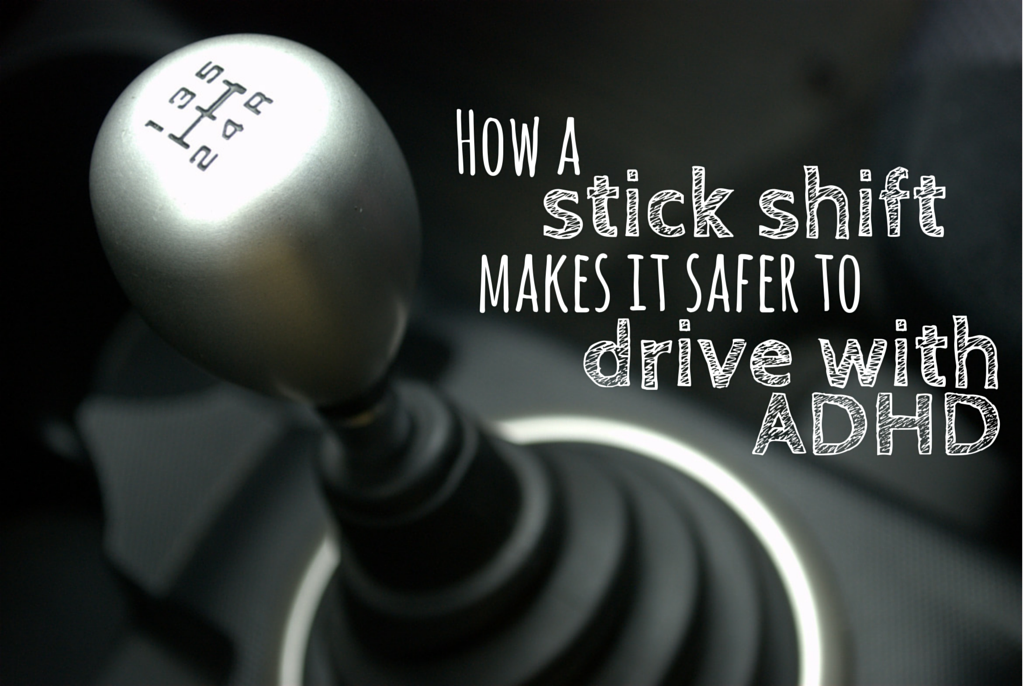Are you a good driver?
Is your spouse or teen with ADHD a good driver?
We might hate to admit it, but the answer is often, “no” or “it depends.” ADHD cripples the executive functions required for safe and conscientious driving.
Thanks to lower maturity levels and lack of driving experience, teens and young adults are especially at risk. Young ADHD drivers are significantly more likely to have multiple car crashes, to suffer injuries from those accidents, and to be at fault in a crash.

Walking into a lamppost can be funny — the same mistake in a car quickly turns tragic. As Jeff Emmerson of Living With Adult ADD writes, “all it takes is a split second to take a life when we’re distracted.”
Driving with ADHD: how to stay safe
The best thing you can do to protect you, your family, and others on the road is to take your medication. It’s the only proven way to make an ADHD’er a better driver.
But we aren’t always on our meds, and for some, that’s not enough.
As it turns out, driving a stick shift may reduce your risk of being in an accident.
Many ADHD’ers — myself included — say they feel like better drivers with a manual transmission. A study from MIT confirmed it: people with ADHD performed better in a driving simulation when using a stick shift.
Driving a stick shift forces you to focus your whole body on driving. You consistently use both hands and feet, you need to know how fast you’re going and what gear you should be in, and you need to control your speed when you start from a standstill. Many drivers say it’s just more fun. Keeping your mind and body engaged will help you avoid fidgety, stimulation-seeking behaviors and distractions.
Not only that, that fact that you need both hands to operate the steering wheel and gearshift may make you save the food or cell phone for later.
Another angle to consider: as a new driver, my trusty five-speed Toyota Camry kept me in the parking lot for longer than my peers. Experts recommend giving ADHD teens more supervised practice hours to monitor and develop driving skills. Spending more time getting used to the mechanics of the car — in an empty parking lot, away from high-pressure, high-stakes situations — ensured that once I hit the road, I felt 100% comfortable with the basics.
While stick shifts have gone out of vogue in recent years, they have distinct advantages for ADHD’ers. If you’re shopping for a car, give it some thought. All my cars, since that very first one nearly 15 years ago, have had manual transmissions. It really does make me feel more in control — of the car and myself.
And when it comes to car safety, I want as many statistics on my side as possible.
Hey there! Are you enjoying The ADHD Homestead?
Here's the thing: I don't like ads. I don't want to sell your attention to an advertising service run by the world's biggest data mining company. I also value my integrity and my readers' trust above all, which means I accept very few sponsorships/partnerships.
So I'm asking for your support directly. For the cost of one cup of coffee, you can help keep this site unbiased and ad-free.
Below you will find two buttons. The first lets you join our crew of Patreon pals and pledge monthly support for my work. Patrons also have access to my Audioblogs podcast. The second takes you to a simple donation page to pledge one-time or recurring support for The ADHD Homestead, no frills, no strings. Do whichever feels best for you!

